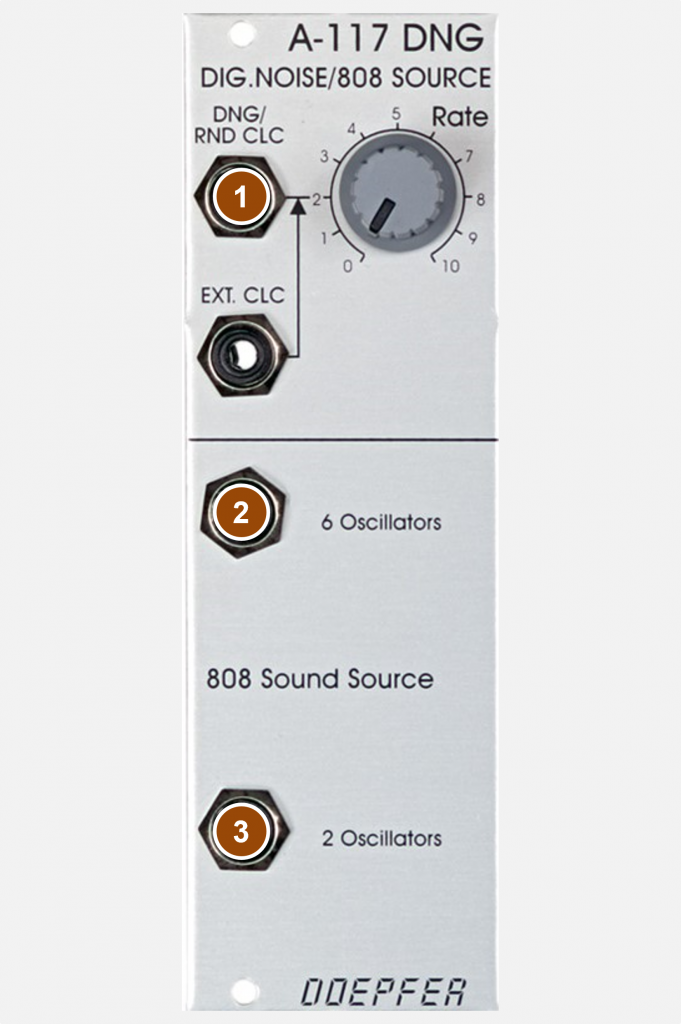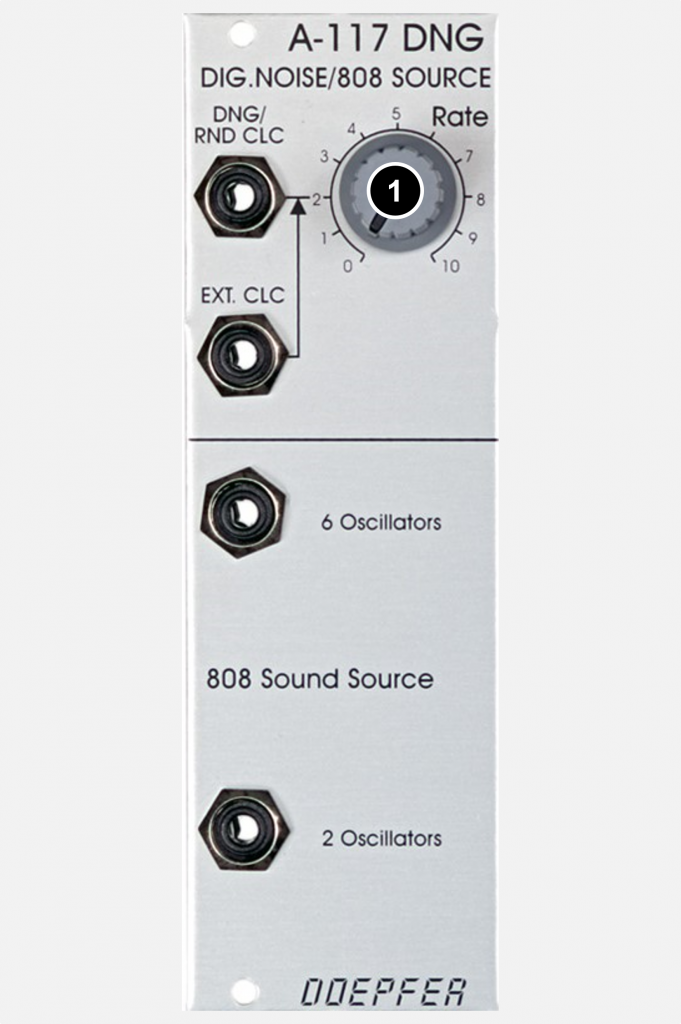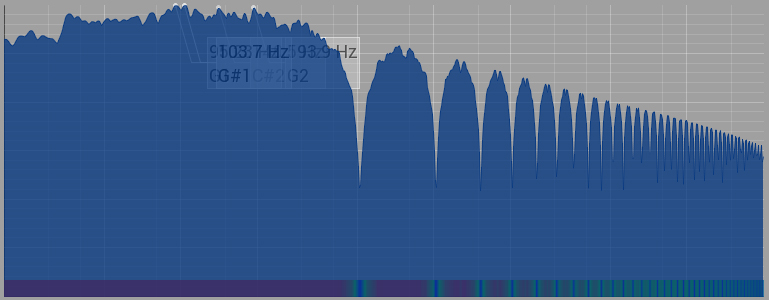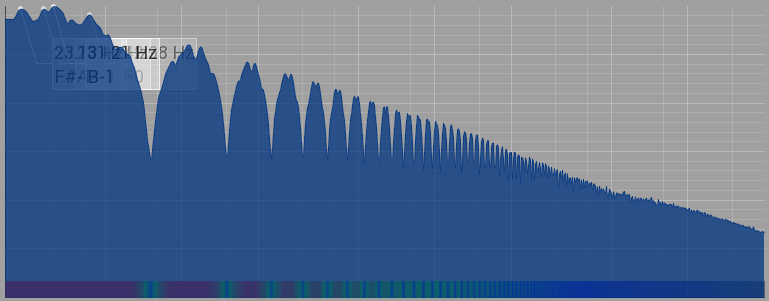The A-117 Digital Noise / Random Clock / 808 Sound Source module is a discontinued model and will no longer be produced in the future.
Status: February 2024
The Digital Noise Generator A-117 creates random, short impulses. The frequency of these pulses can basically be controlled, namely via the “Rate” controller or alternatively via an externally applied clock. In contrast to an oscillator, the respective occurrence is “yes or no” as well as the length of such a pulse is random (technically “pseudo-random” due to the generation via shift registers, but musically clearly “random enough”).
This gives us a very special noise that can be tuned down to individual impulses, “clicks”. The impulses can also be used as trigger signals: The basic frequency of the trigger impulses is always retained, but not every impulse is “fired” or has the same length.
Somewhat counterintuitively, the “Rate” control produces the highest frequency (white to blue noise) at “0” and the lowest frequency (random single pulses) at “10”.
Noise floor
When looking at the oscilloscope, you can see that the individual pulses are approximately square-wave signals. You can also see here that the last pulse is about twice as long as the previous pulses.
The spectrum clearly shows that with higher “Rate” settings, the low-frequency components of the signal increase and the high-frequency components decrease:
In addition to the digital noise, the A-117 also offers two different “808 Sound Source” outputs with a metallic sound, suitable for use as a hi-hat, cymbal (“6 Oscillators” output), cowbell (“2 Oscillators” output), etc. in an electronic drum set.
User interface
Inputs:

- EXT. CLC: Trigger input for external clocking of the digital random generator. This can be a sequencer or an LFO. With a voltage controlled clock source (e.g. A-147 VC LFO) the timbre of the noise can be (indirectly) controlled by voltage.
Outputs:

- DNG / RND CLC: Digital noise or, at low frequencies, also random trigger signals.
- 6 Oscillators: Six strongly detuned oscillators as the basis for cymbal-like sounds. There are no other options for intervening in the sound.
- 2 Oscillators: Same principle as the 6 Oscillators, but with only 2 Oscillators. As a result, the sound is a bit more metallic and can be used well for “cowbells” etc.
Controls:

- Rate regulates the period of time between two random pulses: If the slider is set to a low position, you get a sound similar to white noise (opposite to what is stated in the PDF instructions). At higher positions, the spectrum of the noise changes due to the decreasing density of the pulses, until individual pulses can already be heard. If even slower random pulses are desired, the A-117 must be controlled with the square output of an LFO.
Possible uses
Semi-random accents
Accents that are random and therefore very “lively” but not a-rhythmic can be created with the A-117. For this purpose, the master clock of the sequencer is reduced to e.g. eighth notes via a frequency divider (e.g. A-160-1, A-163 etc.) and then used as an external clock for the A-117.

With the impulses from the A-117 you can then trigger an A-140 ADSR and use its envelope signal for the second control input of the filter / VCA of a running sequencer voice.
Similar results can also be achieved with an A-149-2 Digital Random Voltages (plus A-149-1) or an A-155 Analog Sequencer with A-154 Sequencer Controller in random mode. However, the A-117 is much cheaper.
Control voltages with the A-117
Both the A-117 and A-118-1 modules are not only practical sound generators for “noisy” sounds, but can also generate random control voltages. With the A-117, this is a random sequence of trigger impulses that can be either “on” or “not on” in an adjustable grid.
Sound examples
-
A-117 / Noise spectrum
The module sounds clearly digital at higher rate values and thus delivers a completely different spectrum of sounds than the A-118, which works with transistor noise. In the following sound example, the Rate control is turned up from “0” to “10” and back to “0”:
-
A-117 / Control via external clock
As an alternative to the Rate control, the frequency of the noise generator can also be controlled via an external clock signal. The Rate control then has no function. In the following sound example, this clock signal comes from an A-111-1 VCO whose frequency is randomly controlled via an A-149-1 Quantized Random Voltages. In order to control the A-117, the basic frequency of the A-111-1 must be set comparatively high (here +4 octaves). The A-149-1 is clocked by an A-146 LFO:
-
A-117 / Drum-Machine
In the following sound example, the A-117 is used as a drum set. The digital noise is processed via an A-124 Wasp filter and an A-132-3 VCA, the envelope comes from an A-142-1 VC Decay. I process the “6 Oscillators” output in a similar way: Here an A-123 24dB highpass filter and also an A-132-3 are connected downstream. The “2 Oscillators” output goes straight into an A-132-3 VCA. Filters, decay lengths etc. are modulated via an A-149-1. The triggers come from an A-157 trigger sequencer.

Experienced modularists take photos of important or complex patches to be able to reproduce them at any time.
Technical specifications
| Width | 8 HP |
| Depth | 40 mm |
| Power requirements | 20 mA (+12V) / -10 mA (-12V) |




